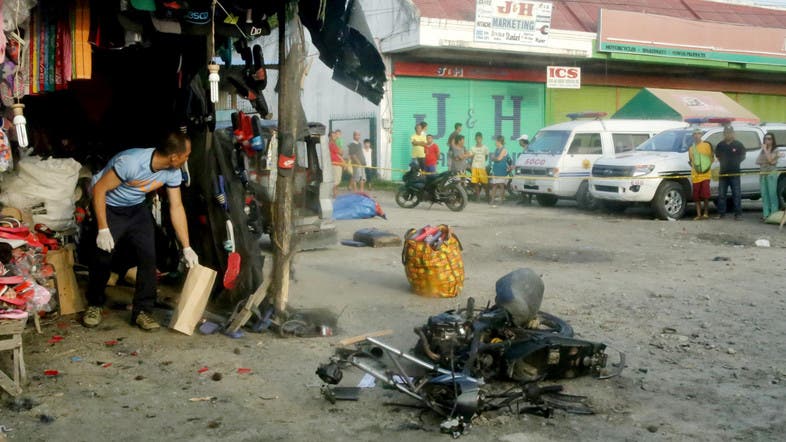From BenarNews (Mar 16, 2019):
Senior Filipino IS Leader Believed Killed in Firefight, Philippine Military Says
 Villagers drive past armored personnel carriers and Philippine security forces in Ampatuan town in the southern province of Maguindanao, Dec. 24, 2015. AFP
A senior leader of Filipino militants who escaped when troops retook the southern Philippine city of Marawi from Islamic State-linked fighters two years ago is believed to be among insurgents killed during clashes earlier this week, military officials said Saturday.
Villagers drive past armored personnel carriers and Philippine security forces in Ampatuan town in the southern province of Maguindanao, Dec. 24, 2015. AFP
A senior leader of Filipino militants who escaped when troops retook the southern Philippine city of Marawi from Islamic State-linked fighters two years ago is believed to be among insurgents killed during clashes earlier this week, military officials said Saturday.
Humam Abdul Najib (alias Abu Dar) is likely one of two militants slain in clashes near the town of Tubaran town in Lanao del Sur province on Thursday. Three soldiers were also killed, and three others who were reported missing had already been accounted for, the military said.
Tissue samples gathered from the slain militants were being processed for DNA testing, though results were not expected for weeks, military spokesman Col. Gerry Besana told BenarNews.“The death of Abu Dar is still for verification,” Besana said, referring to Najib's alias. But Besana emphasized that witnesses on the ground, including residents in the area, had offered visual confirmation. “This will be validated by DNA testing," he said.
Besana said a .45-caliber pistol that was among several firearms recovered in the area had been positively identified as owned by Najib.
Najib was among those who helped plan the five-month Marawi siege with the Maute brothers and Isnilon Hapilon, the overall regional leader of the IS. Several Southeast Asian IS militants, as well as fighters from the Middle East, were also among those who helped carry it out.
The siege, the biggest that was launched in the region by the IS, led to heavy battles that killed 1,200 people, most of them militants. Filipino forces, long used to jungle fighting, had to adjust to urban guerrilla warfare. Australian and U.S. forces were later called in to help in intelligence work, mostly providing aerial and other technical support that helped pinpoint enemy positions.
Hapilon was killed in October 2017, while Najib and several fighters escaped as troops closed in on their positions in Marawi, military officials said.
Najib is believed to have studied in an Islamic school in the northern Philippines, before going to Afghanistan for jihad training in 2005. He is an expert bomb maker, and had at one time ran basic military training for fresh recruits in the southern Philippines, according to military officials.
Col. Romeo Brawner, commander of the Army 103rd Infantry Brigade, said a forensics teams took saliva and tissue samples from the body. He said a portion of the samples was given to the U.S. forces based in the southern city of Zamboanga for DNA analysis.
“I was told the results will take more than one month. Until then, we cannot say categorically it was Abu Dar who was killed,” Brawner told BenarNews. But, he said, all the telltale marks were present on the dead man’s body, except for a mole and knife scars.
 A profile and photograph of Filipino militant Abu Dar is seen in this photograph handed out to reporters by the Philippine Army, January 2018. [HO/Philippine Army]
A profile and photograph of Filipino militant Abu Dar is seen in this photograph handed out to reporters by the Philippine Army, January 2018. [HO/Philippine Army]An officer who asked not to be identified said the body was wearing the same clothes usually worn by Abu Dar as seen on captured videos – black cargo pants and black shirt.
“The residents and a group of former Maute fighters who surrendered, told us the body was Abu Dar,” Brawner said.
“The samples and test will provide the answers if it is indeed him,” he said.
Fighting between government forces and two militant factions had been going in separate parts of Mindanao since Monday. At least 22 fighters of the IS-linked Bangsamoro Islamic Freedom Fighters (BIFF), including a militant with Arabic features, have been killed during gunbattles in the province of Maguindanao, officials said.
On Wednesday, three soldiers and two militants, including the one believed to be Najib, were killed in clashes near Marawi city.
Last year, military official had estimated that at least 40 foreign fighters were still believed to be fighting in Mindanao, many of whom had slipped into the south across its porous borders with neighboring Malaysia and Indonesia.









